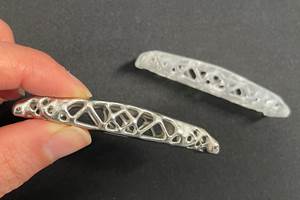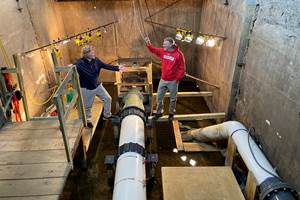Windform Composite 3D Printing Materials Enable Lightweight, Flexible Air Inlet
CRP Technology recently developed a new front air inlet for a Moto3 racing customer, which was manufactured in Windform materials by using an SLS additive manufacturing technique.
Share
Read Next
This article originally appeared on compositesworld.com.
Earlier this year, additive manufacturing provider CRP Technology (part of CRP Group) launched Windform RL, the first thermoplastic elastomer material within the Windform family of materials for professional 3D printing.
Now CRP’s R&D department has developed a new front air inlet for a Moto3 racing customer, which was prototyped and manufactured in Windform materials using a selective laser sintering (SLS) additive manufacturing technique.
According to CRP Technology, testing had shown that increasing air flow to the air-box improved the performance of the engine at every rpm range. This led the team as well as the engineers to conclude that they need to design a new track-ready inlet. This design would make the air inlet longer, and bring the opening up to the front side of the fairing, in order to have a direct air flow with less turbulence.
CRP wanted to avoid modifying the existing frame and the existing triple clamps. The design would have to fit to the existing platform in order to test the on-track advantages and disadvantages of using this solution, and to make a direct comparison with the current standard inlet.
Once a first draft of the air inlet was developed, a prototype was created in Windform GF 2.0, a composite material with a polyamide base filled with glass and aluminum. The decision to use Windform GF 2.0 was made to reduce costs, while being able to perform multiple tests with multiple prototypes.
The first prototype allowed engineers to see if the design fitment was correct and suitable for assembly. It was revealed by the first design that some sections needed to be changed due to the lack of space available under the lower triple clamp. This problem is further complicated when the bike is cornering and under braking conditions.
To optimize the volume of the inlet duct under the lower triple clamp, the engineers adopted a creative approach and decided to create a portion of the duct in Windform RL, a rubber-like composite material for 3D printing produced by CRP Technology. This would be bonded to the main structure that was made out of Windform XT 2.0 for evaluation in racing conditions. The engineers also carried out a bonding test to study the characteristics of the final assembly.
The concept was to make the bottom part of the duct with Windform RL in the fork and triple clamp area, and then assemble this into the top part produced in Windform XT 2.0. This approach would allow clear airflow on the straightaway sections of the course, and thus improve flow to the airbox. Under breaking, the front fender could move up and collapse the inlet duct without any damages, due to the flexible material.
The team and engineers eventually decided to change the inlet by reducing the portion that would make contact with the fender to reduce drag perceived by the rider. The part made in Windform RL was enlarged according to the second test, and engineers and the rest of the team could get the correct fit for performance.
In the final test version, Windform XT 2.0 was utilized in order to reduce the weight of the front and central part of the inlet, while the Windform RL material was used for the flexible part of the inlet. The two parts were bonded together after being produced.
Related Content
Possibilities From Electroplating 3D Printed Plastic Parts
Adding layers of nickel or copper to 3D printed polymer can impart desired properties such as electrical conductivity, EMI shielding, abrasion resistance and improved strength — approaching and even exceeding 3D printed metal, according to RePliForm.
Read MoreLarge-Format “Cold” 3D Printing With Polypropylene and Polyethylene
Israeli startup Largix has developed a production solution that can 3D print PP and PE without melting them. Its first test? Custom tanks for chemical storage.
Read MoreHow Large-Format 3D Printing Supports Micro-Scale Hydropower
There is potential hydroelectric power that has never been unlocked because of the difficulty in capturing it. At Cadens, additive manufacturing is the key to customizing micro-scale water turbine systems to generate electricity from smaller dams and waterways.
Read MoreDrones Take Flight with Metal and Polymer 3D Printed Parts: The Cool Parts Show Bonus
Drones produced by Cobra Aero now incorporate many 3D printed parts made through laser powder bed fusion and Multi Jet Fusion processes.
Read MoreRead Next
At General Atomics, Do Unmanned Aerial Systems Reveal the Future of Aircraft Manufacturing?
The maker of the Predator and SkyGuardian remote aircraft can implement additive manufacturing more rapidly and widely than the makers of other types of planes. The role of 3D printing in current and future UAS components hints at how far AM can go to save cost and time in aircraft production and design.
Read More4 Ways the Education and Training Challenge Is Different for Additive Manufacturing
The advance of additive manufacturing means we need more professionals educated in AM technology.
Read More3D Printing Brings Sustainability, Accessibility to Glass Manufacturing
Australian startup Maple Glass Printing has developed a process for extruding glass into artwork, lab implements and architectural elements. Along the way, the company has also found more efficient ways of recycling this material.
Read More














.png;maxWidth=300;quality=90)










